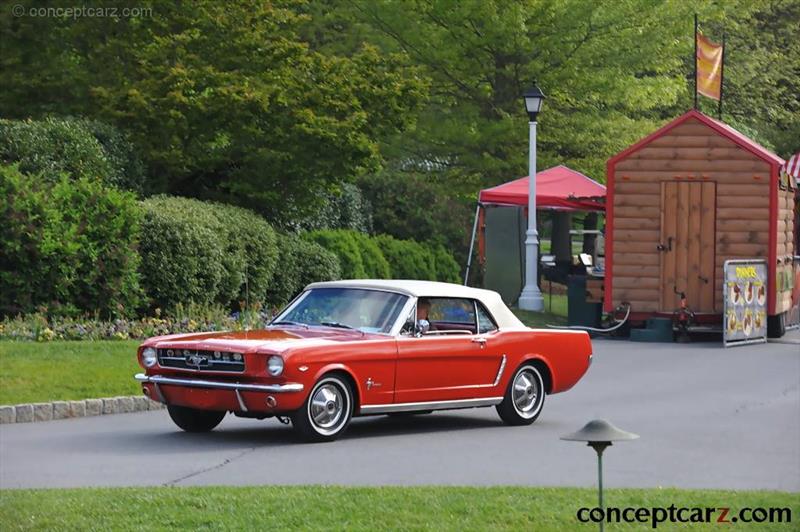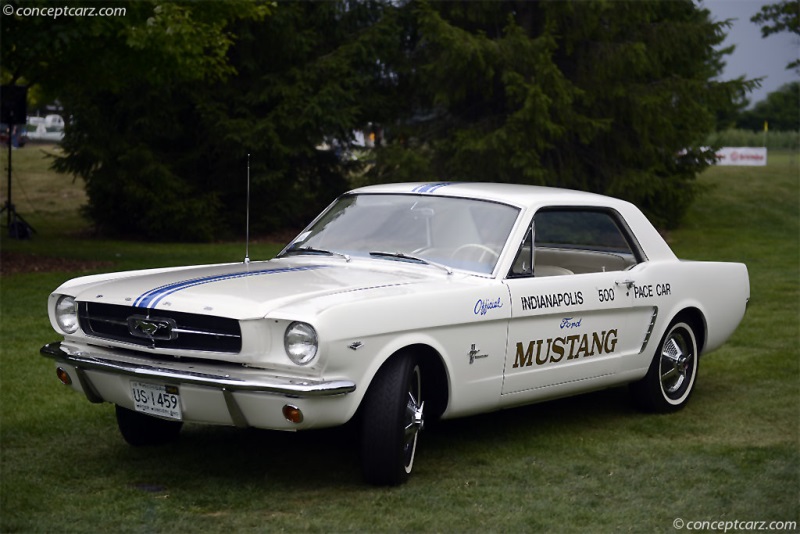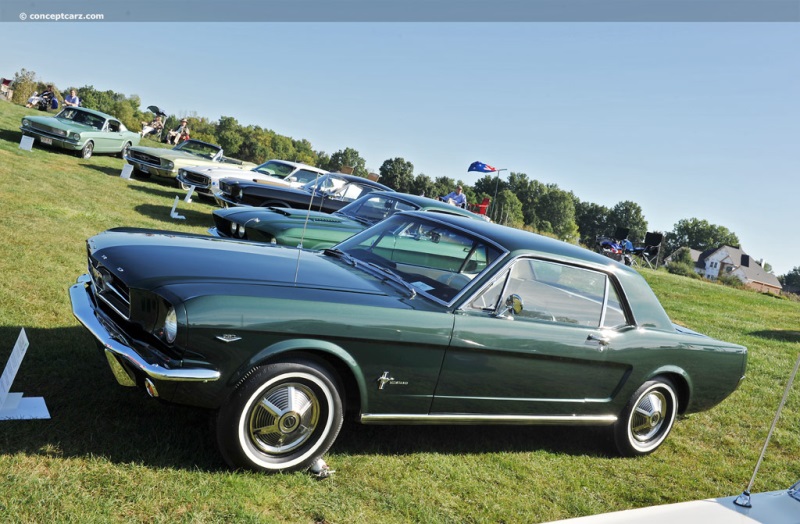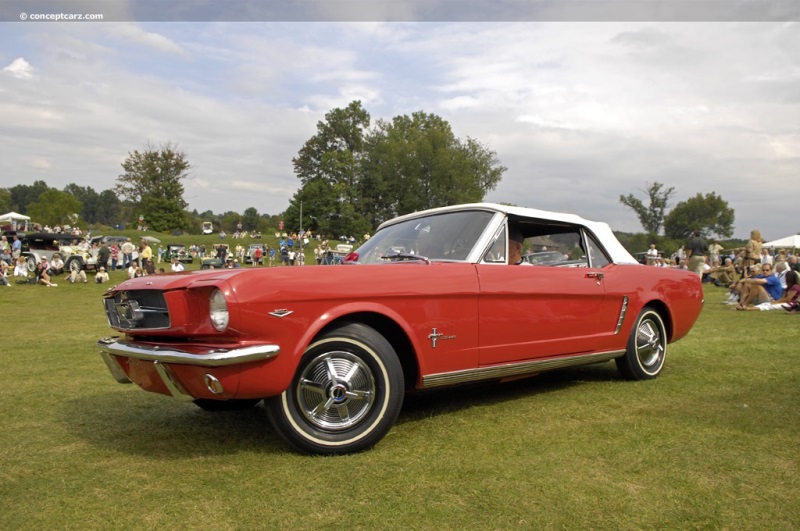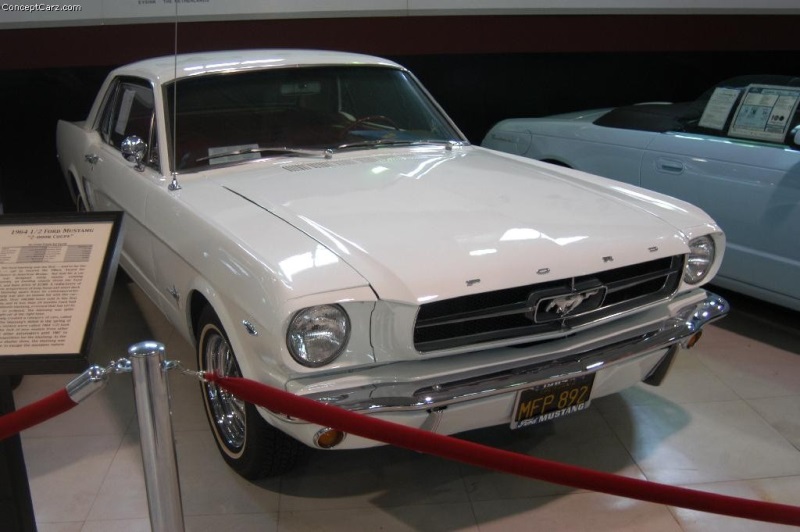1964 Ford Mustang Navigation
The Ford Mustang spawned a new 'Pony Car' market and offered a combination of personal luxury, sporting performance, and crisp styling. It was an overnight nationwide sensation when it was introduced in April of 1964 at the New York World's Fair, and part of its appeal was its vast array of options making it truly customizable and unique. It was aimed at affluent youth who desired a car that was as much a lifestyle statement as a means of transport. It offered great value-for-money, decent economy, brisk performance, and sporty looks. Ford projected first-year sales to reach around 100,000 examples, however, this figure was achieved in a mere four months, making its introduction the most successful in automotive history. 524,791 examples were sold in 1965. One million Mustangs were on American roads by 1966, and it is the only original pony car to remain in continuous production since its unveiling. 
Convertible
View info and historyDue to its mid-year introduction in 1964, the earliest examples of the Mustang were titled as 1965 models but are known unofficially as 1964 ½ cars. They were VIN coded and titled by Ford as 1965 models, although production began five months before the normal start of the 1965 production year, on March 9th of 1964 in Dearborn, Michigan. Introduced to the public on April 17th, the Mustang appeared favorably in approximately 2,600 newspapers the next morning.Lee Iacocca was the brainchild of the Mustang, and Donald N. Frey was the head engineer for the Mustang project (the T-5 project). He supervised the overall development of the car during its record 18-month creation. Eugene Bordinat was vice-president of design at Ford and tasked three design studios with creating proposals for the new vehicle. The winning design was ultimately created by the Ford Design Studio under Project Design Chief Joe Oros and his team of L. David Ash, Gale Halderman, and John Foster. The source of the 'Mustang' was suggested by executive stylist John Najjar, who was a fan of the World War II P-51 Mustang fighter plane. Najjar co-designed the first prototype of the Ford Mustang known as Ford Mustang I in 1961, working jointly with fellow Ford stylist Philip T. Clark. The Mustang I was introduced on October 7th of 1962 at the United States Grand Prix in Watkins Glen, New York. Formula One race driver Dan Gurney drove the second 'race' prototype in demonstration laps around the track, with his lap times only slightly off the pace of the F1 race cars. The 1962 Ford Mustang I two-seater concept was followed in 1963 by the Mustang II four-seater concept, using a variation of the production model's front and rear ends with a roof that was approximately 2.7-inches shorter. 
Hardtop Coupe
Chassis #: 5F07F123722
View info and historyThe name 'Mustang' may have come from Robert J. Eggert, Ford Division market research manager and a breeder of quarterhorses. He gave his wife a book entitled, The Mustangs by J. Frank Dobie in 1960 - the title inspired him to add the 'Mustang' name for Ford's new concept car. The name 'Mustang' could not be used in Germany as it was owned by Krupp, who manufactured trucks between 1951 and 1964. So Mustangs sold in Germany were called the 'T-5' until December of 1978.The Ford Mustang was originally based on the platform of the second-generation North American Ford Falcon. It was a four-seat car with front bucket seats and a rear bench seat. A 'Fastback 2+2', first manufactured on August 17, 1964, enclosed the trunk space under a sweeping exterior line. The list price in the United States began at $2,368 and many of its components, including the suspension, chassis, and drivetrain, were derived from the Ford Falcon and Fairlane lines. This allowed its price to be low, production to commence quickly, a shorter learning curve for assembly and repair workers, and gave dealers the freedom of not investing in additional spare parts inventory to support the new car line. The Dearborn factory produced both the Mustang and the Falcon, but its popularity quickly exceeded the plant's production capacity. In July, Ford's San Jose, California plant helped supplement production, and soon the Falcon assembly line at Metuchen, New Jersey, was converted to Mustang production as well. 
Hardtop Coupe
View info and historyThe base engine was the 'U-code' 170 cubic-inch (2.8-liter) straight-6 unit sourced from the Falcon, backed by a three-speed manual transmission. Standard equipment included a glove box light, a padded dashboard, and black front seat belts. V8 models received a badge on the front fender that spelled out the engine's cubic-inch displacement (either '260' or '289') over a wide 'V' - the same emblem used on the 1964 Fairlane. About four months into the Mustang production, several changes occurred including the engine lineup, with a 200 CID (3.3-liter) 'T-Code' engine offering 120 horsepower. The Fairlane's 'F-code' 260 CID (4.3-liter) engine ceased production when the 1964 model year ended and was replaced by a new 200 horsepower 'C-code' 289 CID engine with a two-barrel carburetor as the base V8. Additional engines included the 'A-code', four-barrel carbureted version offering 225 horsepower, and the unchanged 289 HiPo 'K-code' with 4-barrel Autolite 4100 carburetion rated at 271 hp at 6,000 RPM and 312 lb-ft at 3,400 RPM. A new AC alternator replaced the DC electrical generation on all Fords.Standard equipment included an AM radio, standard Falcon instrumentation, a floor-mounted shifter, and adjustable driver and passenger bucket seats. The Interior Decor Group, also known as the 'Pony Interior,' added embossed running ponies on the seat front, integral armrests, round gauge cluster, and woodgrain applique accents. Options included a remote-operated mirror, a floor console, sun visors, a bench seat, and vinyl with cloth insert seats (this option was offered only in early 1965 models). Later options included an under-dash air-conditioning system. Rocker panel moldings, power brakes, power steering, push-button radio with antenna, deluxe retractable front seat safety belts, Special Handling Package, Accent Group, Equa-Lock limited-slip differential, and Heavy-duty battery were just a few of the Mustang's options. Mustang GT
15,079 Ford Mustangs were built in 1965 as GT versions fitted with the 'GT Equipment Package.' This group of options included grille-mounted fog lamps, rocker panel stripes, disc brakes, and a V8 engine, usually the '289' 225 hp. The interior received a unique instrument panel that included an ammeter, oil pressure gauge, speedometer, and fuel gauge in five-round dials. Rally-pac
Ford's success at the 1963 Monte Carlo Rally spawned the Rally-Pac option available on Ford and Mercury compact and intermediate vehicles. This option group added a combination clock and tachometer mounted to the steering column. The factory-installed feature cost $69.30 (US) or $75.95 when installed by a dealer. 14-inch rims were available for Rally-Pac and GT350R vehicles which required widening the front and rear track to 57.5-inches. Additional options included back-up lights, a compass, rear seat belts, and air conditioning. Competition
The Mustang would enjoy a lengthy and often glorious competition career, commencing not long after its introduction when a pair of works-backed cars entered by Alan Mann Racing finished 1st and 2nd in class in the 1964 Tour de France international rally. Roy Pierpoint drove a Mustang to overall victory in the 1965 British Touring Car championship. In the United States, the Mustang proved very competitive at the drag strip, with a 427 cubic-inch (7.0-liter) engined example winning the NHRA's 'Factory Stock Eliminator' class at the 1965 Winternationls. Carroll Shelby's GT350 Mustangs won five of the SCCA's six divisions in 1965 and the B-Production title again in 1966 and 1967.
by Daniel Vaughan | Aug 2020
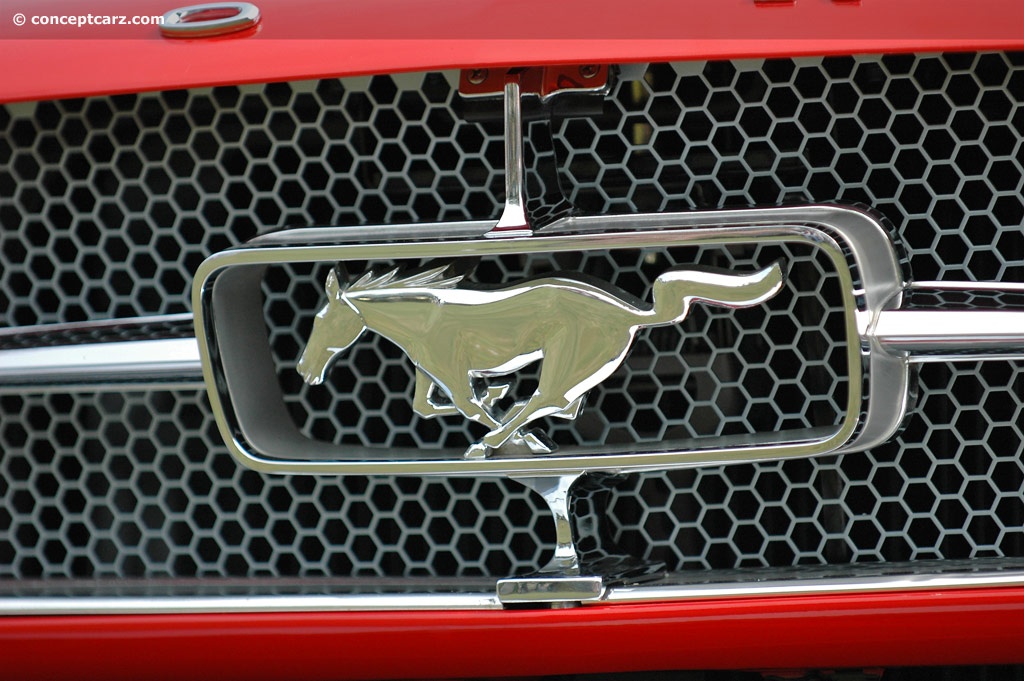
Convertible
View info and history
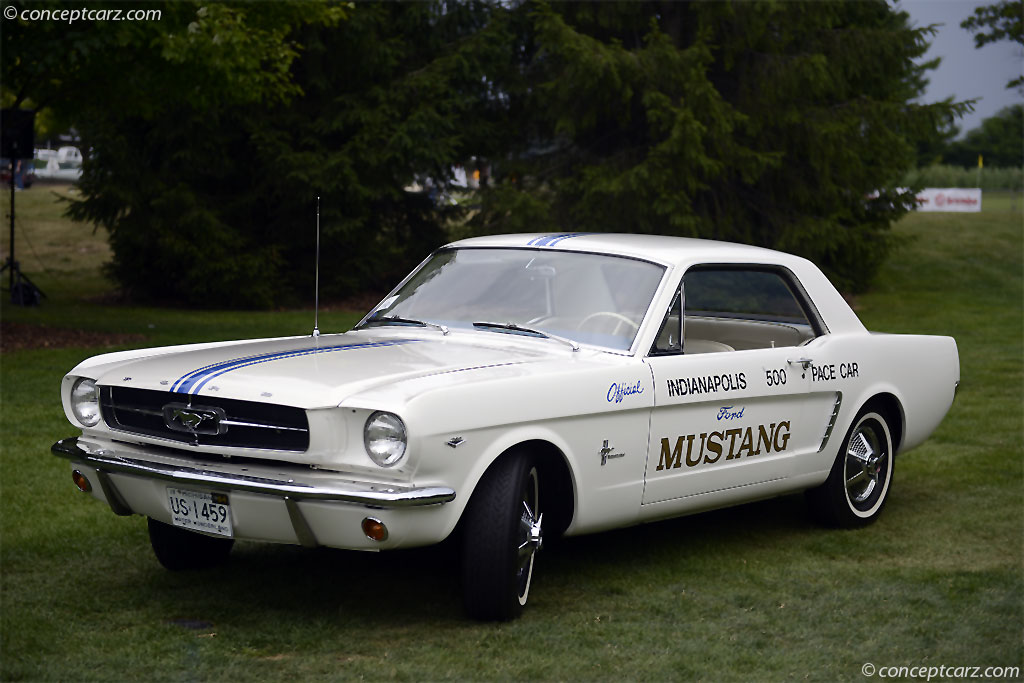
Hardtop Coupe
Chassis #: 5F07F123722
View info and history
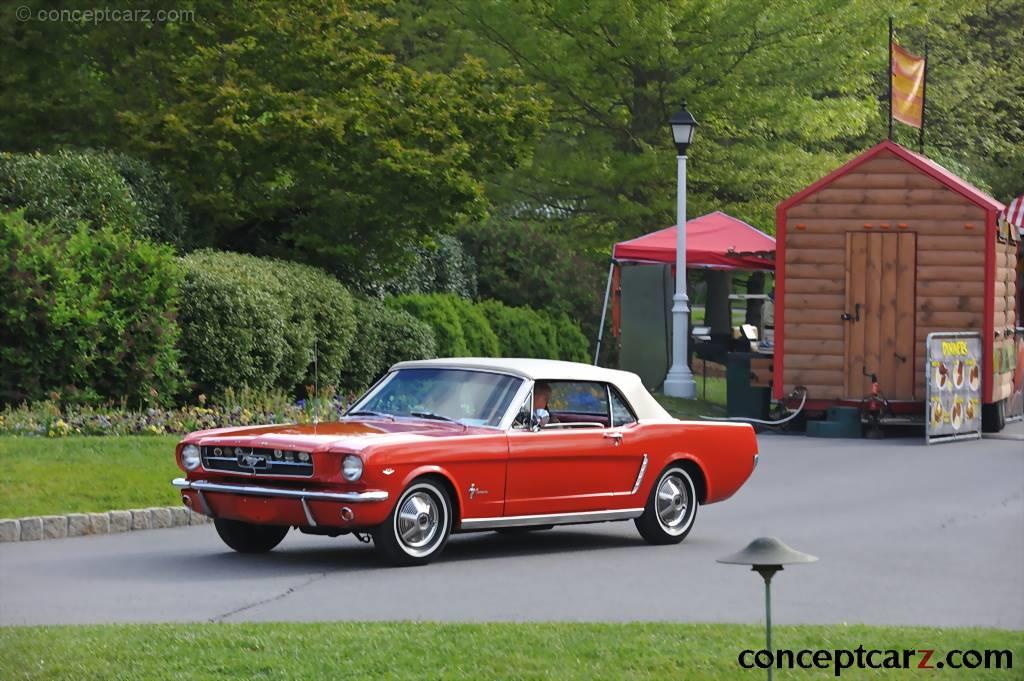
Hardtop Coupe
View info and history
15,079 Ford Mustangs were built in 1965 as GT versions fitted with the 'GT Equipment Package.' This group of options included grille-mounted fog lamps, rocker panel stripes, disc brakes, and a V8 engine, usually the '289' 225 hp. The interior received a unique instrument panel that included an ammeter, oil pressure gauge, speedometer, and fuel gauge in five-round dials. Rally-pac
Ford's success at the 1963 Monte Carlo Rally spawned the Rally-Pac option available on Ford and Mercury compact and intermediate vehicles. This option group added a combination clock and tachometer mounted to the steering column. The factory-installed feature cost $69.30 (US) or $75.95 when installed by a dealer. 14-inch rims were available for Rally-Pac and GT350R vehicles which required widening the front and rear track to 57.5-inches. Additional options included back-up lights, a compass, rear seat belts, and air conditioning. Competition
The Mustang would enjoy a lengthy and often glorious competition career, commencing not long after its introduction when a pair of works-backed cars entered by Alan Mann Racing finished 1st and 2nd in class in the 1964 Tour de France international rally. Roy Pierpoint drove a Mustang to overall victory in the 1965 British Touring Car championship. In the United States, the Mustang proved very competitive at the drag strip, with a 427 cubic-inch (7.0-liter) engined example winning the NHRA's 'Factory Stock Eliminator' class at the 1965 Winternationls. Carroll Shelby's GT350 Mustangs won five of the SCCA's six divisions in 1965 and the B-Production title again in 1966 and 1967.
by Daniel Vaughan | Aug 2020
Related Reading : Ford Mustang History
The Mustang was introduced at the 1965 New York Worlds Fair, Mustang Mania instantly swept the country, and a new automotive market segment was created - the 22 or better known as the ponycar. Though its mechanical underpinnings descended from the Falcon, the Mustang was completely different. It was a compact, tight, clean package weighing in at a modest 2,550 pounds - a departure from the ever-enlarging....
Continue Reading >>
Continue Reading >>
Related Reading : Ford Mustang History
The Ford Mustang first appeared in 1964 and was immediately popular for its style and its capabilities. The largest engine offering of the time was the 289 V-8 K-code small block engine which was sufficient but enthusiasts wanted and demanded more power. The base engine was a six-cylinder power plant. The body style configurations included coupe, convertible and fastback. In its first year of....
Continue Reading >>
Continue Reading >>
Related Reading : Ford Mustang History
A pillar of American automotive lore, the Mustang is the vehicle the brought sporting dash and styling at a price that almost everyone could afford. Always extraordinarily attractive, the Mustang has been capturing the hearts of drivers for nearly 40 years. Introducing a whole new breed of automobile, the pony car, Ford wasnt content to stand on the sidelines while others jumped ahead. Rather than....
Continue Reading >>
Continue Reading >>
- 1964 Ford Mustang Menu
- Article
- Image gallery
- Valuation
- Specifications
- Profiles
- Production figures
Ford
Similar Vehicles
Similar Automakers
Similarly Sized Vehicles
from 1964
- Austin FX4 Taxi
Bizzarrini Iso Grifo A3/C
BMW 3200CS
Facel Vega Facel II
Ferrari 330 America
Ford Falcon
Ford Falcon A-XS
ISO Rivolta
Jaguar 3.8 MKII
Jensen C-V8 MK II
Similarly Priced Vehicles
1964 Ford Mustang Vehicle Profiles
Recent Vehicle Additions
Performance and Specification Comparison
Price Comparison
$1,985 - $2,660
$2,050 - $2,260
$2,180 - $2,600
$2,460 - $2,615
$2,611 - $3,485
$3,780
$4,485 - $4,851
Mustang - Generation I Specification Comparison by Year
Year
Production
Wheelbase
Engine
Prices
126,538
108.00 in.
6 cyl., 200.00 CID., 116.00hp
8 cyl., 289.00 CID., 195.00hp
8 cyl., 289.00 CID., 225.00hp
8 cyl., 289.00 CID., 271.00hp
8 cyl., 289.00 CID., 195.00hp
8 cyl., 289.00 CID., 225.00hp
8 cyl., 289.00 CID., 271.00hp
$2,368 - $2,612
559,451
108.00 in.
6 cyl., 200.00 CID., 120.00hp
8 cyl., 289.00 CID., 200.00hp
8 cyl., 289.00 CID., 225.00hp
8 cyl., 289.00 CID., 271.00hp
8 cyl., 289.00 CID., 200.00hp
8 cyl., 289.00 CID., 225.00hp
8 cyl., 289.00 CID., 271.00hp
$2,370 - $2,612
607,568
108.00 in.
6 cyl., 200.00 CID., 120.00hp
8 cyl., 289.00 CID., 200.00hp
8 cyl., 289.00 CID., 225.00hp
8 cyl., 289.00 CID., 271.00hp
8 cyl., 289.00 CID., 200.00hp
8 cyl., 289.00 CID., 225.00hp
8 cyl., 289.00 CID., 271.00hp
$2,415 - $2,650
472,121
108.00 in.
6 cyl., 200.00 CID., 120.00hp
8 cyl., 289.00 CID., 195.00hp
8 cyl., 289.00 CID., 271.00hp
8 cyl., 390.00 CID., 320.00hp
8 cyl., 289.00 CID., 195.00hp
8 cyl., 289.00 CID., 271.00hp
8 cyl., 390.00 CID., 320.00hp
$2,460 - $2,695
317,148
108.00 in.
6 cyl., 200.00 CID., 115.00hp
8 cyl., 289.00 CID., 195.00hp
8 cyl., 302.00 CID., 230.00hp
8 cyl., 390.00 CID., 280.00hp
8 cyl., 390.00 CID., 325.00hp
8 cyl., 428.00 CID., 335.00hp
8 cyl., 427.00 CID., 390.00hp
8 cyl., 289.00 CID., 195.00hp
8 cyl., 302.00 CID., 230.00hp
8 cyl., 390.00 CID., 280.00hp
8 cyl., 390.00 CID., 325.00hp
8 cyl., 428.00 CID., 335.00hp
8 cyl., 427.00 CID., 390.00hp
$2,600 - $2,812
108.00 in.
6 cyl., 200.00 CID., 120.00hp
8 cyl., 302.00 CID., 220.00hp
8 cyl., 390.00 CID., 225.00hp
8 cyl., 390.00 CID., 265.00hp
8 cyl., 428.00 CID., 335.00hp
8 cyl., 429.00 CID., 375.00hp
8 cyl., 302.00 CID., 220.00hp
8 cyl., 390.00 CID., 225.00hp
8 cyl., 390.00 CID., 265.00hp
8 cyl., 428.00 CID., 335.00hp
8 cyl., 429.00 CID., 375.00hp
$2,615 - $3,120
197,045
108.00 in.
6 cyl., 200.00 CID., 120.00hp
6 cyl., 250.00 CID., 155.00hp
8 cyl., 302.00 CID., 220.00hp
8 cyl., 351.00 CID., 250.00hp
8 cyl., 302.00 CID., 290.00hp
8 cyl., 351.00 CID., 300.00hp
8 cyl., 351.00 CID., 330.00hp
8 cyl., 428.00 CID., 360.00hp
8 cyl., 429.00 CID., 375.00hp
6 cyl., 250.00 CID., 155.00hp
8 cyl., 302.00 CID., 220.00hp
8 cyl., 351.00 CID., 250.00hp
8 cyl., 302.00 CID., 290.00hp
8 cyl., 351.00 CID., 300.00hp
8 cyl., 351.00 CID., 330.00hp
8 cyl., 428.00 CID., 360.00hp
8 cyl., 429.00 CID., 375.00hp
$2,720 - $3,715
151,428
109.00 in.
6 cyl., 250.00 CID., 150.00hp
8 cyl., 302.00 CID., 210.00hp
8 cyl., 351.00 CID., 240.00hp
8 cyl., 351.00 CID., 240.00hp
8 cyl., 351.00 CID., 330.00hp
8 cyl., 429.00 CID., 370.00hp
8 cyl., 302.00 CID., 210.00hp
8 cyl., 351.00 CID., 240.00hp
8 cyl., 351.00 CID., 240.00hp
8 cyl., 351.00 CID., 330.00hp
8 cyl., 429.00 CID., 370.00hp
$2,910 - $4,120
102,589
109.00 in.
6 cyl., 250.00 CID., 98.00hp
8 cyl., 302.00 CID., 140.00hp
8 cyl., 351.00 CID., 163.00hp
8 cyl., 351.00 CID., 256.00hp
8 cyl., 351.00 CID., 266.00hp
8 cyl., 302.00 CID., 140.00hp
8 cyl., 351.00 CID., 163.00hp
8 cyl., 351.00 CID., 256.00hp
8 cyl., 351.00 CID., 266.00hp
$2,730 - $3,100
134,817
109.00 in.
6 cyl., 250.00 CID., 88.00hp
8 cyl., 302.00 CID., 135.00hp
8 cyl., 351.00 CID., 154.00hp
8 cyl., 351.00 CID., 156.00hp
8 cyl., 302.00 CID., 135.00hp
8 cyl., 351.00 CID., 154.00hp
8 cyl., 351.00 CID., 156.00hp
$2,765 - $3,190
Related Automotive News

SIDE-BY-SIDE 1965, 2015 MUSTANG DISPLAY SHOWCASES 50 YEARS OF INNOVATION AT NATIONAL INVENTORS HALL OF FAME MUSEUM
Ford and the National Inventors Hall of Fame Museum will debut a permanent Mustang display that uniquely fuses 50 years of history by combining a 1965 Mustang and a 2015 model – both split lengthwise – with two functional driver compartments
Mustan...

Alan Mann Racing honored with Spirit of Ford Award
Alan Mann Racing becomes 28th recipient of the prestigious Spirit of Ford Award following decades of racing and winning with Ford cars around the world
Edsel B. Ford II presented the award to Henry and Tom Mann at a special Mustang celebration eve...
RRDC Evening With Emerson Fittipaldi A Highlight Of Long Beach Grand Prix
LONG BEACH, Calif. (April 7, 2017) - The April 6 RRDC Evening with Emerson Fittipaldi Presented by Firestone boasted a capacity crowd of auto racing dignitaries, corporate executives and champion race-car drivers, as the two-time Formula 1 and...
RRDC VOTES IN 26 NEW MEMBERS FOR 2015
HILLIARD, Ohio (Oct. 23, 2015) - Twenty-six race-car drivers and motorsports professionals have been voted into the Road Racing Drivers Club in 2015. The group includes 11 Regular Members from the open-wheel and sports-car racing ranks, 10 Associate...
RRDC VOTES IN 37 NEW MEMBERS FOR 2013
HILLIARD, Ohio (Nov. 7, 2013) - Thirty-seven race-car drivers and motorsports professionals have been voted into the Road Racing Drivers Club in 2013. The group includes 13 Regular Members from the open-wheel and sports-car racing ranks, 20 Associate...

Limited-Edition Ford Racing History Artwork Unveiled at SEMA; Limited-Edition Print Sales to Benefit JDRF
Special limited-edition Ford Racing history artwork is unveiled at the annual SEMA show as part of the Ford press conference
Famed automotive artist Sam Bass created the artwork at the request of Edsel B. Ford II, with proceeds from sales of limit...



































